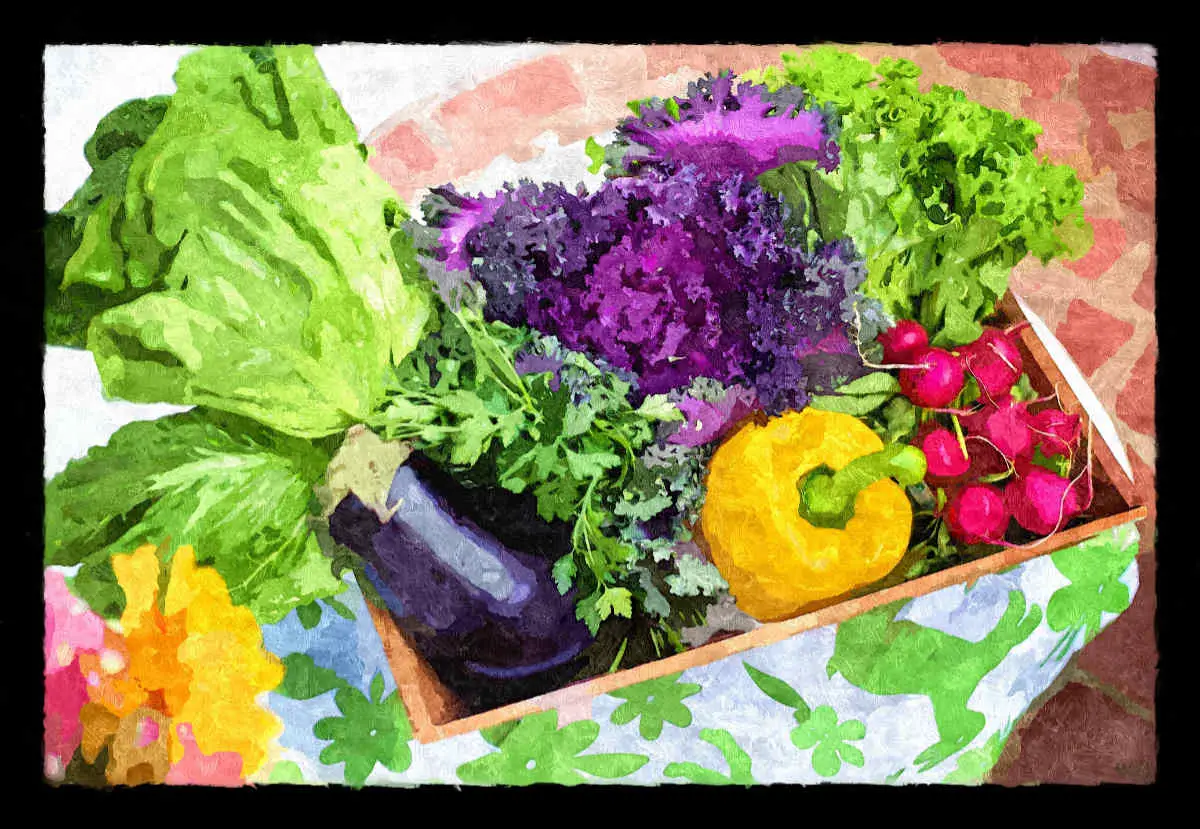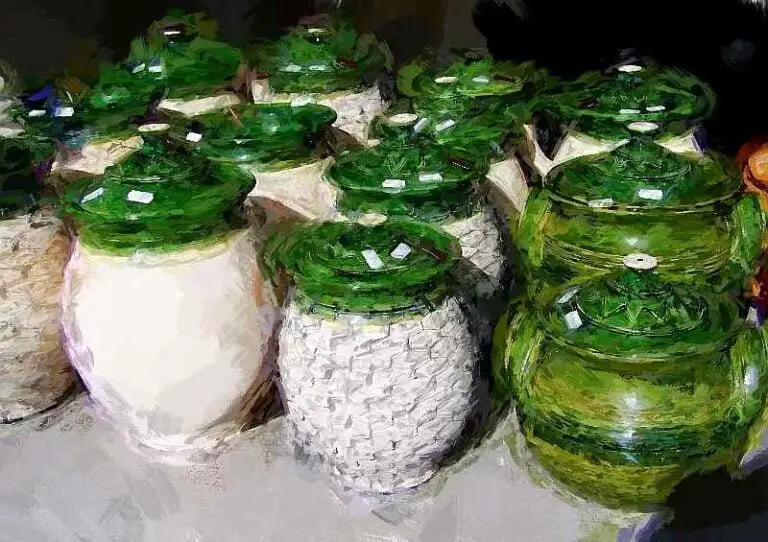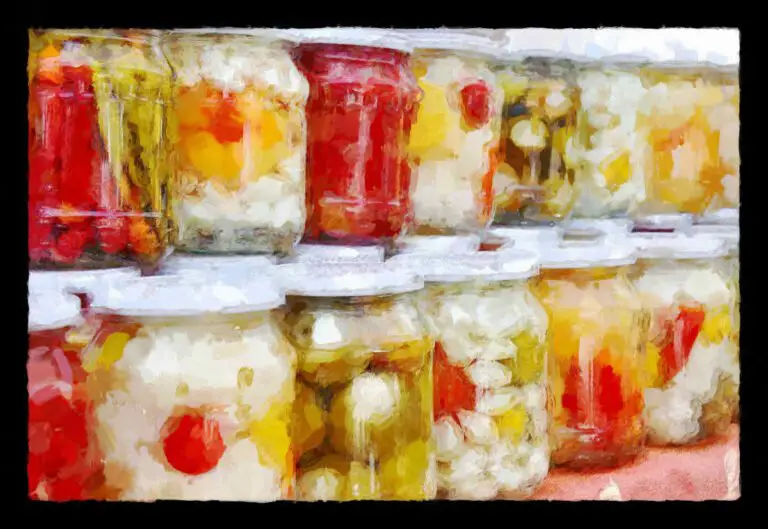Top 30 Fermentation Questions Answered
Botulism, how and when to use a starter, lacto fermenting fruit and vegetables, benefits and dangers of fermented foods and more.
Approaching fermentation is at once exciting and scary.
Its vastness and potentials are so wide – and wild – that we risk giving up even before trying.
Furthermore, the answers to our many questions are often difficult to find, being that they are scattered all over the web, social media groups, pins and more.
Also, more times than not, the available information looks conflicting with answers given by people who hardly have an idea of what they are talking about.
So for the same vegetable ferment we see salt concentration being anything from 0.5 to 5%, whey added to pretty much anything under the sun, fermentation times going from 1 day to whatever.
I know.
I have been there too.
Now we know more than what we knew at the beginning and we have decided to help you out by answering the most common questions about home fermentation.
Let’s begin
What is fermentation?
What a big question you asked!
I won’t go into the details of chemical equations, use utterly complicated words or very hard to swallow concepts because the world wide web is already full of them.
So here is my answer; I hope it will be useful for you as it has been for me at the time.
Via fermentation we are able to preserve, create and completely transform food by using common everyday ingredients, namely salt and sugar.
Such ingredients, together with basic equipment and simple techniques, constitute the trifecta that help microorganisms grow and thrive.
It is by those very microorganisms, mainly bacteria and fungi, that the process of fermentation is carried on, a process that without them would never occur.
So thanks to them we can turn cabbage into sauerkraut or water and flour into sourdough starter.
Why should I ferment food?
First and foremost fermentation applied to food allows us to preserve fresh and raw produce for a long time without it being impoverished.
Fermented food is also more nutritionally dense than the non fermented counterpart on top of being more bio available to our body.
Which means that your body is able to better absorb more vitamins and minerals from fermented carrots than from carrots prepared in any other way.
So when you eat fermented fruit and vegetables you will benefit from the nutrients already present in them with the addition of those CREATED by and during fermentation.
In particular vitamins B2, B12 ( folate ) and C together with vitamin K2 which exists only in fermented products.
Is fermented food good for you?
The short answer is, absolutely yes!
With that said, the longer answer is that you should ALWAYS consult your doctor before adding anything new to your diet.
Your doctor will tell you if, given your medical history, you can safely consume fermented food and benefit from it.
No website, no book, nor article can substitute and should never substitute the advice given by a professional.
What are the benefits of eating fermented food?
According to several recent studies the benefits of eating fermented foods are many and also quite significant.
It is quite commonly known that fermentation produces probiotic food and that probiotics play a very important role for the health of our intestine.
Eating fermented food can increase the variety of the microbiota of human guts and reduce inflammation of the body as a whole.
Other studies have shown how fermented food can have anti cancer properties, help lower cholesterol, aid with diabetes, high blood pressure and more.
These are some of the reasons why fermented food is considered healthy.
Do probiotics make it to the intestine?
Yes, according to several studies, probiotics from fermented food survive the acid environment of the stomach and actually make it to the gut.
When there they will contribute to better and enrich the microbiome of your intestine.
Are fermented vegetables safe to eat?
Yes they are, given you have followed best practices and government guidelines for food handling and preparation.
To this day there is no knowledge of reported cases of severe food poisoning as a consequence of eating fermented food
Controlled fermentation is a proven method to combat harmful microorganisms, that’s why it has been used for millennia to preserve food.
Can botulism grow in fermented food?
If you follow best practices and government guidelines for food handling and preparation it is very hard for botulism to grow in fermented food.
In fact when we lacto ferment vegetables we intentionally create an environment where lactic acid bacteria can thrive and LAB are known for keeping pathogens at bay.
Furthermore, botulism grows in low salt and low acidity environments; in lacto fermentation the right concentration of salt for every vegetable or fruit is used and the ph is quickly brought down to 4.1.
Botulism is more commonly found in home canned food than in fermented food for the above reasons.
What are the dangers of fermented food?
The main dangers of fermented food are associated with unwanted microorganisms growing in and on our produce.
It is now evident how important it is to control the fermentation process, because if we don’t control it someone else will.
As soon as fruit and vegetables are detached from the plant they immediately start decaying and being transformed into nutrients for the soil.
To do that, nature calls upon moulds, fungi and bacteria that are potentially harmful for human health; these are the very microorganisms we must not welcome in our fermented food.
What’s the difference between pickling and fermenting?
Generally speaking pickling , as the name suggests, is obtained by using a pickling liquid made with vinegar, water, salt, often sugar and herbs or spices.
The pickling liquid is usually heated up, vegetables are poured in and left for a few minutes, then both are placed inside jars.
So as you can see, no fermentation is involved.
Traditionally pickled cucumbers are a category on their own as they have always been made by submerging them in salty brine.
Indeed they ARE fermented.
Fermenting vegetables ( or fruit or anything else ), on the other hand, implies creating a suitable environment for good bacteria to grow, colonising our produce and transmuting it into a living food full of probiotics.
Can you ferment vegetables with vinegar?
Not really; in fact vinegar works perfectly as a preserving agent but is not good at all as a medium to fermentation.
Find out why in the next question.
Does vinegar stop fermentation?
Generally speaking we could answer this question with a YES but I think it’s important to clarify a little further.
There are two significant aspects to consider in this answer: acidity of the vinegar and quantities.
We can all imagine that adding 50ml of fruit scrap vinegar, known to be very low in acidity, will impact the ferment in a very different way than if we added the same amount of a 6% acidity vinegar.
The same goes for quantities: adding 50ml to a 1L jar is not the same as adding 200ml.
Imagine to combine these two variables with the size of the jar, the temperature of your home, the type of vegetable, their degree of ripeness and sugar content, in all their possible permutations.
All of a sudden the answer to the question is not as easy and straightforward as we previously thought.
So, if a small amount of vinegar added to a ferment can enhance its flavour and slightly slow down the fermentation process, a significant one could almost stop it entirely.
This is the reason why we always suggest to swap the fermentation brine with a pickling one when vegetables have reached a flavour profile you like.
There is also another aspect to consider.
When we lacto – ferment vegetables we want lactic acid bacteria to colonise and “own” the fermentation stage as undisturbed as possible.
Acetic acid bacteria are a different kind of microorganisms all together and they need completely different conditions to grow and thrive.
In fact they need an abundance of oxygen to reproduce and multiply.
It becomes very clear how mixing such different microorganisms can have unpredictable effects on fermentation and even alter its natural phases.
Is vinegar fermented?
Yes it is; in fact it follows the yeast to alcohol fermentation pathway.
For example if you take apple juice and place it in a closed container, you will soon see the yeasts naturally present in fruit start breaking down sugar and turn it into alcohol.
When all sugar has been consumed, oxygen is needed for acetic acid bacteria to transform alcohol into acetic acid.
…and this is the story of how vinegar is made…
Do lacto fermented vegetables contain milk or dairy?
In spite of the name, lacto fermented vegetables ( and fruit ) do not contain any form of dairy or milk so, even if you are lactose or dairy intolerant, you can safely consume them.
Lacto, in fact, refers to the lactic acid bacteria (LAB ) which, during the fermentation process, convert sugars into lactic acid.
Lactic acid is the substance responsible for the typical sour and tangy taste.
The only potential issue is when people decide to add whey to their vegetables thinking it will kickstart the fermentation.
So the answer to the question is that if lacto fermented vegetables (and fruit) are made properly they do NOT contain any dairy or milk.
But if someone gifts you a jar of their ferments, always ask if they have added whey to it.
And obviously the next question has to be this:
Do I need to add whey to ferment vegetables?
No, no, no and again NO.
When fermenting vegetables and fruit the best results are obtained by using salt; no starters are needed.
In fact adding whey means adding an animal product, populated with its own microorganisms, to a vegetable product that has its own.
Such microorganisms of the two products differ so much that the number of shared ones is often zero.
In other words: adding whey is 100% unnecessary and can even damage your ferment.
But speaking of whey, did you give a look at our recipe to make Blaand the whey wine Vikings used to make?
Do I need a starter culture?
No, generally speaking, you don’t as the bacteria already living in and on fruit and vegetables will be more than enough to start the fermentation.
There is one case, though, where I would advise you to use a starter and that case is when you want to ferment produce whose bacteria might have died.
For example both ginger beer made from a hot infusion or bread kvass made with toasted bread would need a starter culture.
Do I need any special equipment?
For as much as many would like you to think otherwise the answer is that you don’t need any special equipment to lacto ferment fruit and vegetables at home.
All you really need is hygiene, good glass jars and lids, high quality salt and water.
That’s it!
But if you intend to brew fermented drinks at home like beers, fruit wines and meads some other tools will come handy.
A demijohn ( or carboy ), good fermentation airlocks, glass bottles that can withstand pressure and a refractometer or a hydrometer.
Can you ferment food in plastic?
Yes and no.
Many restaurants ferment food in vacuum sealed bags because it’s practical and satisfies the food safety standards required for commercial cooking.
But for homemade fermentation vacuum sealed bags are an expensive overkill and they produce unnecessary plastic waste that can easily be avoided.
Be aware that the acidity produced during fermentation can potentially corrode plastic and cause it to leak substances in your food.
So, for your vegetables and fruit, all you really need are glass jars, but if you decide to ferment in bulk you can use food grade plastic buckets.
But you are really better with plastic bottles when making short fermented and very fizzy drinks like beetroot kvass or pine needle beer.
Can you ferment store bought vegetables?
Yes you can definitely ferment store bought vegetables.
Personally I avoid pesticides as much as possible so if I buy vegetables I always go for organic but if conventional vegetables are all you find, know that you can ferment those too.
Wash them very very thoroughly with water and sodium bicarbonate, rinse them and proceed with fermenting them as you would with any other vegetables.
There is a chance that you might need to use a starter culture if the heavy spraying has killed all the microorganisms.
Can I ferment cooked vegetables?
Yes you absolutely can ferment cooked vegetables!
Indeed a great one to ferment are green beans that are first blanched for a few minutes in boiling water then lacto fermented.
As boiling water kills microorganisms you will need a starter culture ( like sauerkraut brine or similar ) to kick start the fermentation and make it delicious.
Can you ferment frozen vegetables?
Yes to this one too.
Frozen vegetables are your second best choice after fresh ones as they perform really well during fermentation.
Obviously, the above applies particularly to dense vegetables that do not contain a huge amount of juice.
Cabbage, broccoli, carrots are the first that come to mind.
With very juicy or delicate vegetables like capsicums or tomatoes results might not be as great as one would like them to be.
The process of freezing can in fact damage the structure of the entire vegetable.
If freezing is done at home or without a commercial blast chiller, if frozen vegetables are improperly stored, fairly big pieces of ice can form in and around the produce an tear its structure apart.
All the above can cause fermented frozen vegetables to be soft, mushy and quite unpleasant to eat.
How often should I eat fermented food?
As often as you like ( but only AFTER your doctor gave you the fermented food green light )
An average person can eat fermented foods every day, multiple times per day and happily enjoy all the benefits that come from doing so.
The same average person can also consume fermented drinks every day in the form of milk kefir, water kefir, kombucha etc and enjoy even more benefits.
What are the healthiest fermented foods?
Milk kefir, kimchi, and sauerkraut are commonly considered the healthiest fermented foods one can make and consume.
But lacto fermented beets are just as beneficial.
It’s definitely worth starting a fermentation journey with one of them for sure; milk kefir and sauerkraut are the easiest to make, while kimchi requires a few more ingredients and a little experience.
Drink wise both pineapple tepache and beetroot kvass are considered a real blessing for the body.
Fermented, delicious and often zero waste like the never-to-be-thrown-again watermelon rinds…100% win win win.
What is the ideal temperature for fermentation?
Generally speaking we can say that the so-called “room temperature” ( 20 Celsius / 69 Fahrenheit ) is suitable for the majority of fermented foods and microorganisms.
But, in reality, the ideal temperature for fermentation really depends on what you are going to ferment.
So if you are preparing sourdough bread you will want a temperature closer to 26 Celsius / 79 Fahrenheit for a good proofing.
If you are fermenting cabbage to make sauerkraut the ideal temperature is lower; around 17 Celsius / 62.5 Fahrenheit.
Milk kefir tolerates a range of temperatures between 20 and 24 Celsius ( 69-75 F ) and above that you will need to do something to create a cooler environment.
But according to many it ferments very well at much cooler temperatures with different LABs strains….
For fermented drinks like flour kvass, ginger beer and similar, a warmer environment is more suitable to the yeasts involved and allows them to grow faster.
26-28 and even 30 Celsius ( 79-82.5 up to 30 ) is a very good range for them.
Can I ferment without sugar?
If you ferment using the yeast/alcohol pathway you must add some form of sugar as yeasts need it in order to survive and reproduce.
If they don’t reproduce and thrive, fermentation won’t happen.
Vice versa if you intend to use the lacto fermentation pathway sugar is completely unnecessary.
Can I ferment without salt?
It depends on what you are going to ferment.
For a lacto fermentation you need to use salt; for a yeast/alcohol fermentation you won’t need it at all.
Is adding salt necessary to ferment vegetables?
Yes, adding salt is necessary and it is so for several reasons.
First and foremost salt inhibits the growth of unwanted bacteria whilst promoting the growth of good bacteria ( LAB ).
Second, salt will draw water and sugar out of fruit and vegetables, speeding up fermentation and consequently lowering the ph of your vegetables more quickly.
In dry salting the pulling out of juices will also fill up potential oxygen gaps.
Salt will also keep vegetables more crunchy and crisp by acting on the pectin contained in fruit and vegetables.
Although you’ll see online peoples recipes for fermenting vegetables with whey or wine in place of salt, science says reducing salt can be a very risky move.
As proven by studies and researches lowering the amount of salt can increase the growth of pathogens like Clostridium botulinum Bacillus cereus, Staphylococcus aureus, Yersinia enterocolitica, Aeromonas hydrophila, Clostridium perfringens and Arcobacter
Also according to this study conducted in Korea about habitually eating kimchi the results found were the following:
“ Conclusion: High consumption of salt-fermented vegetables was not shown to be associated with increased risk of hypertension “
How can I tell if my fermented vegetables are ready?
To determine if your lacto fermented vegetables are ready you’ll need a few things
- A calendar
- Your eyes
- Your nose
- Your taste buds
- A ph metre ( optional )
For LAB to grow and fully colonise your vegetables an average of two weeks are needed, so as soon as you have jarred them be sure to label and date them.
Periodically releasing the CO2 will give you valuable information such as knowing when gas began to form, when it peaked and when it stopped.
Observing how the vegetables change over time, smelling the released gas and eventually tasting them close to the two week mark will do the rest.
When lacto fermented vegetables smell fermented, taste sour and tangy with a hint of fizz you’ll know they are almost done.
After that my advice is to taste every day until the ferment has reached a flavour profile you are happy with.
After that it’s going to be refrigeration time.
Do you need to refrigerate fermented food?
Refrigerating fermented food is not necessary as fermentation itself is what preserves produce, so storing it in (root) cellars or cool rooms is enough.
The cooler the environment the slower fermentation will be and this is one of the main reasons why fermented food is often stored inside the refrigerator.
At 4 degrees Celsius ( 39 F ), in fact, the activity of microorganisms will be very very slow.
Ultimately it’s really up to you how you store fermented food.
If you consume it fast or don’t mind it tasting quite sour you can keep it in a cool room, if not, the fridge would be a better way to go.
How long does fermented food last?
Lacto fermented vegetables and honey fermented fruit last a really long time and the same goes for alcoholic ferments like beer, wine, mead etc.
( Nearly ) alcohol free fizzy drinks that are fermented for short periods only last a week or so before becoming very sour and tangy.
Lacro fermented fruits, due to the high sugar content, do not last longer than a few days even in a cool or cold environment.
On the other hand fermented vegetables like carrots or tomatoes, to name a couple, can easily last a few months on the shelf and even longer in the refrigerator.
At the end of the spectrum we have vinegars and alcoholic ferments that can last years and are in fact often consumed after aging.
Does fermented food go bad?
Yes, fermented food can go bad and some of the signs it might have actually gone bad are the following
- Bad smell
- Suspicious colour of produce ( blue garlic is normal, don’t worry )
- Something has grown on the surface of the brine
- Something has grown on the produce
- Brine does not have a normal liquid consistency
Mould has grown on my fermented food what can I do?
Unfortunately, all that can be done in such cases is to toss everything in the bin and start a new batch.
It happens to everyone sooner or later…you are not alone!
How can I prevent fermented food from going bad?
Preventing fermented food from going bad is actually quite easy.
Here is how
- sterilise jars and lids before using them
- remove any marked, damaged or bruised part from the produce
- use the right amount of salt
- ( alternatively ) use the right amount of sugar
- keep produce fully submerged at all times
- leave enough headspace in the jar ( 3cm / 1 inch )
- don’t leave too much headspace in the jar ( e.g. a jar half empty )
- keep oxygen away from your ferments
- do not place the fork back in the jar after it has been in your mouth
So here you have it: 30 of your most asked questions have been answered…
We really hope this FAQs marathon helped you to make the decision of giving fermented food a go; it is well worth it, fun to make and fun to experiment with.
If you have questions just write them in the comment section below and we will answer them to the best of our knowledge.
Over to you.
See you soon








Question, what if you start a ferment and it’s only 2 days in and something comes up to where you have to leave home for a few days. Can you put your ferment in the fridge? Then when you come back, a week later, can you bring it out and sit it on the counter to continue fermenting?
Hi Shana!
If you leave the house for just a few days and the temperature in your kitchen is not Summer hot then there is no reason to place it in the refrigerator.
You can simply leave it on the counter and let it ferment on its own, given you are using a type of container that can self-burp and/or won’t explode.
What I do when we need to leave is placing a tray of some description underneath the jar/s to protect whichever surface they sit on from the salty acidic brine.
I hope this helps.